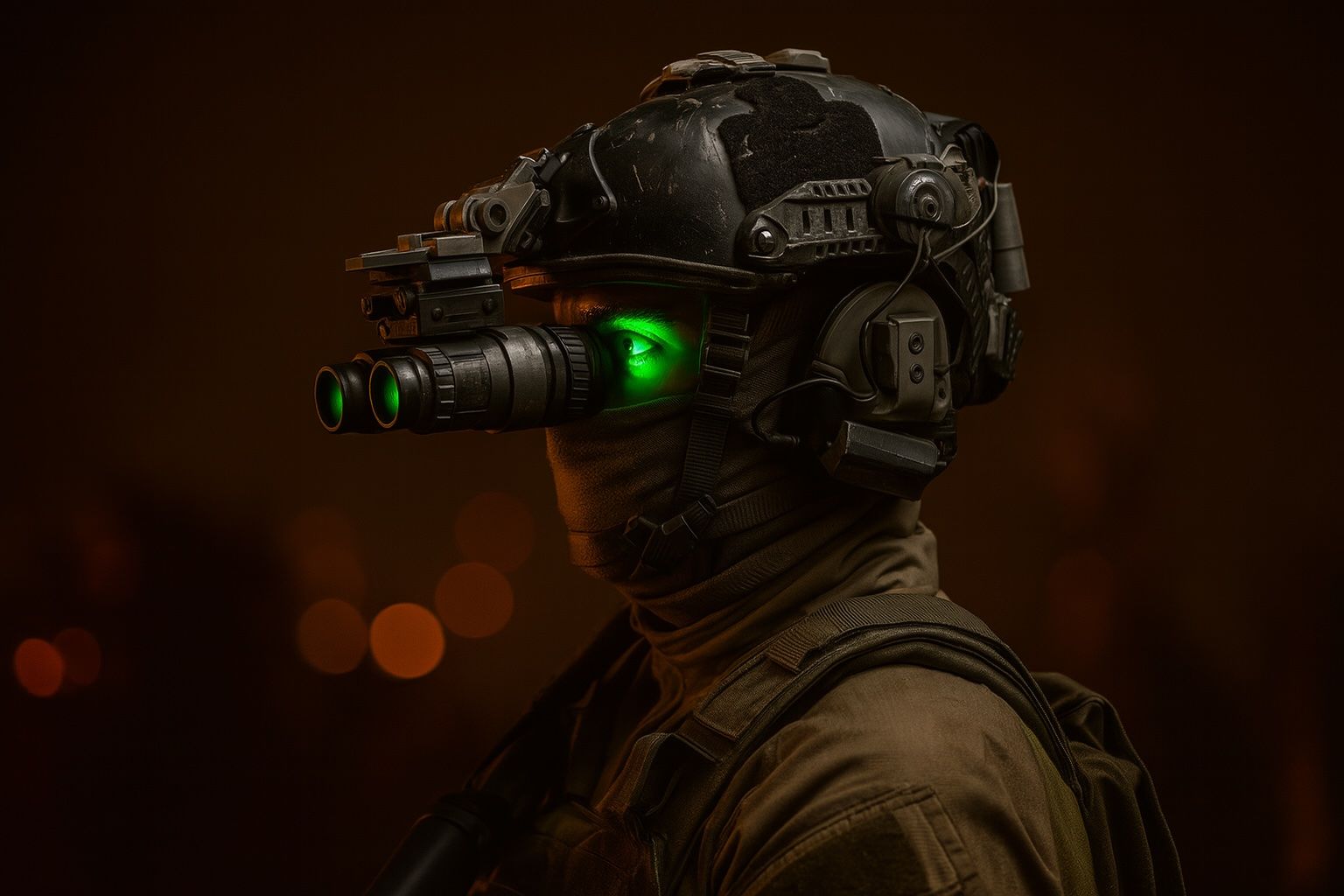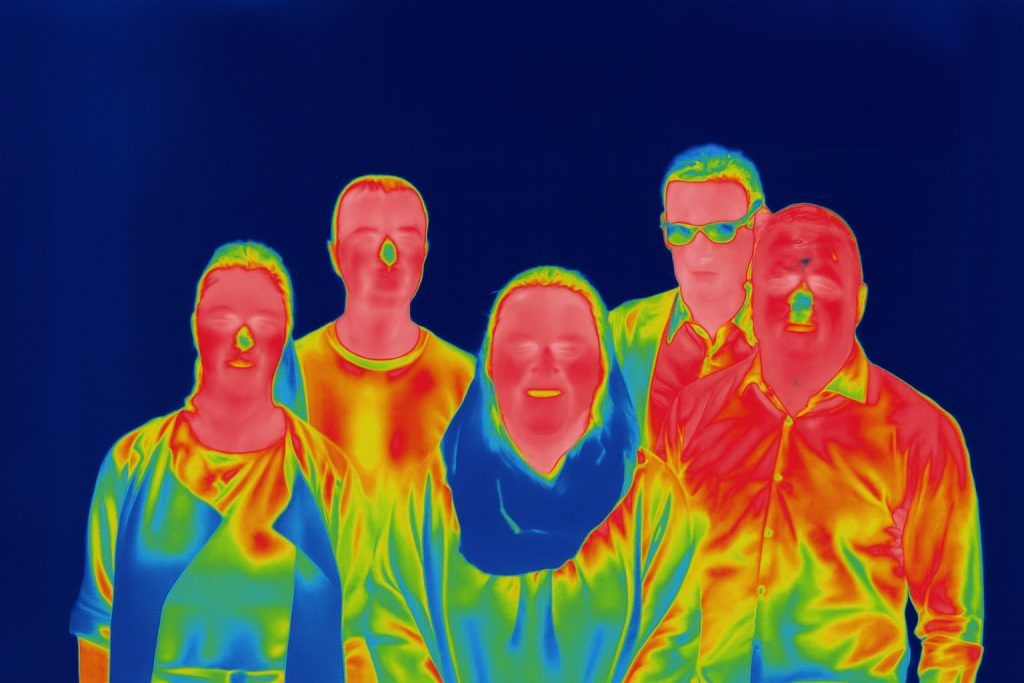- Gen3 image intensifier tubes currently offer a Figure of Merit (FOM) over 2300, with white phosphor tubes replacing green for sharper, higher-contrast views.
- The L3Harris ENVG-B goggles fuse dual white phosphor image intensification with a thermal overlay and have already delivered over 10,000 units to military users.
- The Army’s Integrated Visual Augmentation System (IVAS) is a mixed-reality goggle based on Microsoft HoloLens tech, with IVAS 1.2 delivered in 2023 and field trials ongoing for potential limited deployment by 2025–2026. <li ATN ThOR 5 XD is a thermal rifle scope with a 1280×1024 HD thermal sensor and 4–40× zoom, plus an optional laser rangefinder and onboard ballistic calculator. <li Pulsar Merger XT50 Thermal Binoculars use a 1280×1024 thermal sensor, include digital image stabilization, a built-in laser rangefinder, and 2.5× base magnification. <li The ATN TTM-18 / Odin XMFT 4-in-1 Thermal can serve as clip-on, standalone scope, helmet goggle, or handheld monocular, using a 640×480 (<20 mK) sensor with 1× native magnification and 4× digital zoom, about 8–10 hours on a 18650 battery, and a civilian 640 model around $4,000 with a 320 option. <li ATN X-Sight 5 day/night riflescope uses a 4056×3040 sensor and can support up to 240 fps for fast motion capture. <li Consumer night vision ranges from under $200 for basic digital monoculars to over $10,000 for mil-spec Gen3 dual-tube goggles, with mid-range digital scopes around $600–$800 and high-resolution thermal options from about $3,000–$6,000. <li Field of view typically runs about 40° for standard analog NVGs, around 97° for panoramic four-tube goggles, and 10–30° for handheld thermal or digital devices. <li Fusion and AR overlays are driving the technology forward, with military examples like ENVG-B and IVAS and civilian fusion offerings such as Night Operators Fusion 3.0 around $500 signaling broader adoption by 2026.
The New Era of Night Vision Technology
Night vision devices are undergoing a rapid revolution as we head through 2025 into 2026. Once limited to military use, modern night vision gear is now available for hunters, law enforcement, and tech-savvy consumers alike. The latest devices span traditional light-amplifying goggles, digital low-light cameras, and thermal imagers, with some cutting-edge systems even fusing multiple technologies for unparalleled nighttime awareness. From helmet-mounted military goggles that merge thermal and image intensification [1] to ultra-HD digital scopes for civilian hunters [2], night vision tech has never been more advanced – or more accessible.
In this report, we’ll compare the major night vision technologies – image intensifiers, digital night vision, and thermal imaging – across various form factors (handheld viewers, helmet goggles, and weapon-mounted scopes). We’ll break down key specs like resolution, field of view, battery life, weight, durability, and price, and highlight the standout models of 2025 along with what to expect in 2026. (Spoiler: some of the newest gear can literally let you “see” heat signatures through smoke [3] or overlay data in your field of view like a video game HUD.)
Let’s dive into the darkness and see what’s new in night vision!
Night Vision Tech 101: Intensifier vs. Digital vs. Thermal
Traditional Image Intensification (Analog Night Vision): These classic night vision goggles (NVGs) amplify faint light. An image intensifier tube takes in ambient light (or starlight/moonlight) and boosts it thousands of times, displaying a green or white monochrome image. Gen 3 intensifier tubes are the current gold standard (used by militaries), offering high clarity and low-light sensitivity. In fact, top Gen3+ tubes now boast a Figure of Merit (FOM) over 2300, indicating exceptionally crisp, high-resolution images [4]. A recent innovation is white phosphor tubes, which replace the old green glow with a black-and-white image that appears sharper and higher contrast [5]. For example, the U.S. Army’s newest ENVG-B goggles switched from green to white phosphor for a brighter, more detailed view of the night [6]. Analog intensifier devices require some ambient light (or IR illuminators in total darkness) and generally provide a 40° field of view, which is standard for most monocular or binocular NVGs [7]. Advanced panoramic goggles with four tubes can reach ~90–100° FOV for much wider peripheral vision [8]. Traditional NVGs excel in low-power consumption – a single AA battery can run a monocular for ~40–50 hours [9] – and they are built to military durability standards (waterproof, recoil-resistant). However, they are expensive (thousands of dollars) and typically only produce monochrome images.
Digital Night Vision: Digital night vision devices use sensitive CMOS sensors or CCD sensors to capture images in low light, then display them on an internal screen (often in color or monochrome). Essentially, these are specialized cameras tuned for low-light, sometimes aided by infrared LEDs. The advantage is that they can often be used day or night (with color daytime imaging), can record video, and cost far less than Gen3 tubes. Resolution is measured in pixels rather than line pairs – and the latest models are pushing into HD and 4K territory. For instance, ATN’s newly introduced X-Sight 5 day/night riflescope sports a 4056×3040 sensor and can even support up to 240 fps for fast motion capture [10]. Many digital night vision scopes and binoculars offer 1080p or higher recording; one popular model, the Luna Optics LN-G3-B50, records 2K QHD video at 30 fps or 1080p at 60 fps [11] [12]. Digital NV devices often feature full-color night vision (using low-light color image sensors) – a dramatic example is the SiOnyx Aurora series which can make night look like dim daylight in color [13] [14]. On the downside, digital units usually have more limited battery life (a few hours on internal batteries or rechargeables), perform best with some IR illumination (for truly dark environments), and can suffer from sensor noise in extreme low light. They’re also electronic, so not as rugged as mil-spec analog gear – consumer units may lack waterproofing (many have no formal IP rating [15] [16]). Still, for consumers and law enforcement on a budget, digital night vision is hugely popular. You can get head-mounted digital goggles for a few hundred dollars, and they’re quite effective for wildlife viewing, navigation, or security. (For example, the budget-friendly Nightfox Swift goggles cost under $200 yet provide basic hands-free night vision for about 3 hours per charge [17] [18].)
Thermal Imaging: Thermal devices don’t rely on light at all – they detect heat. A thermal imager uses an infrared sensor (microbolometer) to create a picture of heat differences in the scene. Warm objects (people, animals, vehicle engines) show up brightly against cooler backgrounds. This gives you the superpower of seeing things through smoke, fog, or foliage that hide them from regular night vision [19]. Thermal scopes and monoculars are incredibly powerful for detection: even a camouflaged person stands out if they’re warmer than the surroundings. Modern thermal imaging scopes typically have sensor resolutions of 320×240 or 640×480 in many civilian models, but 2025 has seen a leap to HD thermal sensors. Both Pulsar and ATN have unveiled thermal optics with 1280×1024 resolution sensors, delivering roughly 4× the pixel count of previous-gen thermals [20]. For instance, ATN’s new ThOR 5 XD thermal rifle scope is built around a 1.3 megapixel (1280×1024) 12μm thermal core at 60 Hz, giving unprecedented image detail in thermal view [21]. Thermal devices usually have interchangeable color palettes (white-hot, black-hot, various colors) to highlight heat sources. They can be handheld viewers, weapon scopes, or even clip-ons. Drawbacks: thermal imagers typically have narrower field of view for a given optic size (high magnification thermal scopes might only be ~10° FOV), and they consume more power (expect 4–8 hours on a charge). They’re also not cheap – high-end thermal binoculars or scopes range from a couple thousand up to $5K+. Like analog NV, though, many thermal units are built tough (hunters need them weatherproof). In law enforcement and military use, thermal is often used alongside traditional NV – each technology has its strengths. Notably, thermal alone does not give the fine detail or identification friend-vs-foe that an intensifier can (thermal shows a target’s shape and heat, but you can’t read signs or see colors). Thus, many professionals use fusion systems that combine the two, which we’ll cover shortly.
Goggles & Monoculars: Handheld or Helmet-Mounted
Analog Night Vision Goggles (NVGs) – Gen3 Tubes Get Better
When you picture elite special forces with night vision goggles, you’re thinking of analog intensifier NVGs. These remain the choice for helmet-mounted night vision due to their proven reliability and instant real-time image (no digital lag). A typical setup is the AN/PVS-14 monocular, a versatile single-tube device that can be hand-held or mounted to a helmet swing-arm. Weighing about 12 ounces, a PVS-14 uses one AA battery for ~50 hours [22] and gives a 40° field of view. Modern PVS-14 units are often equipped with autogated Gen3 filmless white phosphor tubes, meaning they adjust automatically to bright light flashes and present a high-contrast grayscale image. These offer excellent clarity – many have resolution around 64–72 line pairs per mm (equating to very clear imagery) and high FOM ratings in the 1800–2400 range [23]. For users like police SWAT teams or private owners, there are also slightly lower-cost Gen2+ tubes (often from European manufacturers like Photonis) that still provide solid performance at a fraction of the cost of U.S. mil-spec Gen3. A Gen2+ white phosphor goggle can still give a clear 40° view in near darkness, just with a bit more background noise and lesser range compared to Gen3. Prices for analog NVGs vary wildly: a Gen1/Gen2 monocular for casual use might be a few hundred to ~$1,000, but a true Gen3 device is several thousand dollars. High-end dual-tube goggles used by professionals often run $7,000–$10,000 or more [24]. For example, an L3Harris BNVD (binocular night vision device) Gen3 white phosphor system can approach the $10k mark [25]. The upside is durability and trust: these units are waterproof and designed to handle combat conditions.
Dual-tube binocular NVGs give the user stereoscopic vision (better depth perception than a single tube). Popular models in 2025 include the L3Harris PVS-31A BNVD and various articulating bridge goggles. They typically weigh around 1.5–2.0 pounds with mount and battery [26]. Many have an onboard IR illuminator (for map reading or pitch-black rooms) and features like manual gain control. Some goggles like the TNV/RNVG “SuperGain” use specially selected tubes that push FOM and clarity to the max for civilian-legal sales – these are marketed to law enforcement and enthusiast buyers wanting mil-spec performance. At the extreme high end are devices like the GPNVG-18 panoramic goggles (with four image intensifier tubes aligned for a ~97° view). Despite having four tubes, the latest panoramic sets come in around 1.5–1.8 lbs – comparable to dual-tube goggles – by using lightweight housing and an external battery pack [27]. Speaking of battery packs: helmet NVGs often use remote battery packs (mounted on the back of the helmet for counterweight) to extend runtime. For instance, the GPNVG’s pack with four CR123 batteries yields ~30 hours [28]. Dual-tube goggles can also plug into battery packs to go from ~15 hours on a single onboard battery to 50+ hours with an external pack [29]. In short, traditional NVGs in 2025 offer superb low-light vision and ruggedness – and now with white phosphor and better tubes they’re clearer than ever. The trade-off remains cost and the monochrome view. That’s why digital and thermal are finding their own niches.
Digital Night Vision Goggles & Viewers – Budget Friendly, Feature-Packed
Digital night vision has opened up night observation to hobbyists, campers, and budget-limited agencies. Instead of an intensifier tube, these use a low-lux video sensor plus infrared illuminator. Many are designed as binocular-like viewers or camera-style monoculars. A big appeal is that they often include a built-in recorder – you can capture night videos of wildlife or suspects, something analog goggles cannot do without awkward adapters. In 2025, we’re seeing a lot of 4K branding even in budget devices. Some sub-$300 digital binoculars advertise “4K Ultra HD” sensors and 36MP still image capture [30], though in practice their low-light video resolution might effectively be lower due to sensor noise and frame rates. Still, legit higher-end digital units exist: the ATN BinoX 4K binoculars (roughly $900) provide 1080p night vision recording and daytime 4–16× zoom, and they even integrate a laser rangefinder and ballistic calculator to work with smart rifle scopes [31] [32]. Another example, the Luna Optics LN-G3-B50 digital binocular (around $700), features a 3.6 megapixel sensor and dual AMOLED 1280×720 displays for each eye [33], delivering a fairly high-resolution experience. It can function in full color during daytime, then switch to night mode (using either a green, B&W, or amber display palette) for darkness [34].
One exciting area is head-mounted digital NVGs. Traditionally, digital sensors had too much lag or low resolution for comfortable head-mounted use, but that’s improving. For instance, the Nightfox Swift is a cheap head-mounted goggle with a flip-up design – it only gives ~1× magnification and a limited range, but it’s lightweight and lets a user walk around in the dark for under $200 [35] [36]. It uses an IR LED to illuminate the area and an LCD display inside. At the opposite end, there are now even attempts at fusion goggles under $500 that combine a thermal sensor and a digital NV sensor. One such device (the Night Operators “Fusion 3.0” goggle) claims to let users toggle between thermal vision and digital night vision, or even overlay them, at a very low cost [37]. While these budget fusion gadgets won’t match military gear, they demonstrate how far tech has trickled down – a few years ago, thermal fusion was only in the realm of $40k military systems, and now hobbyists can play with a simplified version.
In summary, digital night vision viewers are fantastic for casual use or recording, and they’re found in everything from affordable security cameras to professional wildlife observation kits. Their day/night dual-use adds versatility that analog can’t offer. Just don’t expect the raw range or silky smooth image of a top-tier Gen3 tube – digital NV still needs that infrared light in total darkness and usually has a narrower effective range (often a few hundred yards at best for identifying targets). Battery life also tends to be shorter; you’ll often see 3–8 hours per charge, though some newer models let you attach USB power banks for extended use. Importantly, prices are very approachable: basic digital NV monoculars can be ~$150, and excellent prosumer units fall in the $500–$1000 range – dramatically lower than comparable analog or thermal devices.
Weapon-Mounted Systems: Night Sights for Hunting & Tactical Use
Night vision comes in the form of rifle scopes and clip-on sights as well, allowing shooters to engage targets in darkness. Here we have options in all three technologies: analog, digital, and thermal, each with its role.
Analog Image-Intensifier Scopes/Clip-ons: These are less common on the civilian market but very important in the military. A prime example is a clip-on night vision device like the AN/PVS-30 or newer variants, which mounts in front of a day optic to give it night capability without re-zeroing. These use Gen3 tubes and effectively turn a standard 4× ACOG or riflescope into a night sight for ranges of 300–500+ yards (great for precision shooting under nods). They maintain the resolution and clarity of analog NV, which can be advantageous for target identification compared to some digital scopes. However, they are extremely costly (often >$10k) and heavily regulated for export. Law enforcement sniper units might use them for covert night operations. Dedicated NV riflescopes (with an eyepiece) also exist but are rare outside niche use – most prefer either the head-mounted goggle + infrared laser aiming combination, or nowadays thermal optics, for shooting at night. One recent innovation making analog tech more accessible is miniaturization: companies have demoed clip-on units like the Barska NVD35 that attaches to a regular scope’s eyepiece and feeds it a digital night vision image [38] [39]. (The NVD35 is actually a digital device with a small OLED display, effectively a hybrid approach to give any riflescope night vision.) For the most part though, analog night sights are the domain of the military. For instance, Army and Marine troops have used the AN/PVS-27 clip-on and similar, often paired with their daytime optics, to good effect in low-light missions.
Digital Night Vision Scopes: This is where civilians have a lot of choice. Digital NV rifle scopes look like slightly bulkier traditional scopes with an objective lens, but instead of direct glass optics they house sensors and screens. ATN, Sightmark, Pard, and others lead this space. ATN’s flagship X-Sight series is now in its 5th generation in 2025, boasting an Ultra HD sensor (the X-Sight 5 even touts 4K+ resolution) and a slew of smart features [40] [41]. These scopes can do things like record your hunt in HD video, stream video via WiFi, provide a ballistic calculator and rangefinding (if an LRF module is included or paired), and switch between day color mode and night IR mode at the press of a button. The trade-off is they require power – typically an internal rechargeable battery that might last 8–18 hours. Weight is also higher than a simple glass optic; an ATN digital scope often weighs 2+ pounds. Still, for night hog hunting or varmint control, they are very effective. A hunter can mount a digital day/night scope and use it 24/7. Prices for digital NV scopes are quite reasonable: mid-range models are often around $600–$800, and even top-tier ones with laser rangefinders rarely exceed ~$1200. This puts them well below thermal scope prices. One example: the Sightmark Wraith 4K 4-32x is around $800 and delivers 4K sensor resolution with onboard recording and a long detection range (with an external IR illuminator) – a great value for hog hunters. The downside versus thermal is you still need some illumination; if it’s a moonless night in the field, you must use an IR flashlight or illuminator to see anything at distance through a digital scope. But when you do, the image can be quite detailed (you may even distinguish an animal’s pattern or see its surroundings clearly, which thermal would not show). Law enforcement sometimes employ digital scopes for surveillance or for less-lethal weapons (e.g. fitting a digital NV scope on a paintball gun or pepperball launcher for night riot control training), taking advantage of the recording feature for evidence. Overall, digital scopes are the tech-heavy option – lots of features and data, slightly less low-light performance than analog, but constantly improving.
Thermal Weapon Sights: If you need to detect and engage targets in total darkness at long range, thermal is king. Both the military and increasing numbers of civilian nighttime hunters rely on thermal rifle scopes to spot game or adversaries by heat signature. In 2025, the thermal scope market is extremely hot (no pun intended). Not only have sensor resolutions climbed (with 640×480 sensors common and new 1280×1024 scopes hitting the market [42]), but there are now more options with integrated laser rangefinders (LRF), better zoom, and even applied ballistics. A prime example is the ATN ThOR 5 XD mentioned earlier – its 1280×1024 sensor and 4-40x magnification range set a new bar, and it offers an LRF and can compute ballistic corrections on the fly [43] [44]. Pulsar, a European leader in thermal optics, has the Thermion 2 LRF Pro scopes and others which resemble traditional scopes but are fully digital thermal inside. These often have rechargeable battery packs for quick swaps (e.g. Pulsar’s APS battery system). Battery life tends to be around 6–8 hours continuous for modern thermals – enough for a night hunt, but you’ll want spares for extended operations. Thermal scopes usually have multiple color palettes (you might shoot in white-hot mode, but switch to “black hot” or highlight mode for scanning). They also feature digital zoom which can go up to 10× or more, though at high zoom you are essentially enlarging pixels (image gets fuzzier). A cutting-edge feature on some 2025 thermal scopes is picture-in-picture (PiP), where a small zoomed-in view appears at top of the display to help with precise aiming while keeping a wide field view in the main image [45].
For the military, thermal weapon sights are standard equipment – like the AN/PAS-13 Thermal Weapon Sight family that troops have used for years on rifles and machine guns. Today’s equivalents are lighter and higher-res. There’s also movement toward clip-on thermal imagers that can overlay thermal on a day sight or even on a night vision goggle view (more on fusion in a moment). Some special forces units use devices such as the Optics 1 ECOTI (Enhanced Clip-On Thermal Imager) which attaches to a PVS-31 NVG and adds a thermal overlay, combining the best of both worlds for close combat. While those aren’t exactly “weapon-mounted,” they show how thermal is being integrated across systems.
Pricing for thermal scopes has been dropping slightly, but it’s still significant. An entry-level 384×288 resolution thermal scope might be ~$1,500, a good 640×480 scope ranges $3,000–$5,000, and the new 1280×1024 premium scopes are easily $6,000+. The cost reflects the sophisticated sensors. Nonetheless, hog hunters in Texas swear by even the modest thermal optics – the ability to scan a field and instantly see every warm body (wild pigs, deer, etc.) is a game-changer that neither traditional nor digital night vision can match [46]. Thermal can also see through light cover (brush or grass doesn’t hide a heat signature much) and is immune to flashlights or headlights (which can overwhelm an intensifier). These advantages explain why, for pure tactical use, many say “once you go thermal, it’s hard to go back” [47].
Fusion and Augmented Reality: The Future is Here
One of the most exciting trends at the top end of night vision is sensor fusion – combining intensifier and thermal imagery – and the addition of augmented reality (AR) overlays. These features were once experimental, but in 2025 they are actively fielded in military gear and even starting to trickle to the civilian side.
The U.S. Army’s ENVG-B (Enhanced Night Vision Goggle – Binocular) is a marquee example of fused technology. This helmet-mounted goggle uses dual Gen3 white phosphor tubes combined with a thermal camera, projecting a merged image to the user [48] [49]. In practice, the ENVG-B can operate in several modes: traditional analog night vision, thermal-only, or a fused mode where a thermal outline or overlay is superimposed on the intensifier image [50] [51]. Soldiers using fused goggles can detect a camouflaged target by its heat and see fine detail via intensification – the best of both worlds. The Army is so confident in this tech that it has ordered tens of thousands of ENVG-B units; over 10,000 have already been delivered, with more on the way under new contracts [52] [53]. According to L3Harris, the ENVG-B dramatically improves target recognition at night and even allows sharing video/data to troops’ networks in real time [54] [55]. Troops report being able to hit targets faster and more accurately with these goggles, especially when combined with the Rapid Target Acquisition feature that can wirelessly link the goggle to a weapon’s sight (so you can see your rifle’s view in your eye without looking down the sights) [56] [57]. Essentially, it’s a full heads-up display for night combat.
That heads-up display aspect is further expanded in the Army’s experimental IVAS (Integrated Visual Augmentation System). IVAS is not just night vision – it’s a mixed-reality combat goggle built on Microsoft HoloLens tech, intended to provide overlay maps, compasses, team member locations, and training simulations in addition to low-light and thermal vision [58] [59]. Early versions of IVAS faced challenges (weight, nausea, image quality), but an improved IVAS 1.2 prototype was delivered in 2023 and is undergoing field trials [60] [61]. This latest IVAS has a lower-profile design and improved low-light sensors (likely a form of digital night vision sensor rather than an analog tube) [62]. It also integrates thermal imaging and can pull in feeds from drones or weapon sights to display in the Soldier’s view [63] [64]. The goal is to give soldiers an augmented reality HUD at night – imagine waypoints, enemy highlights, and messages appearing on your goggle view [65] [66]. While IVAS is still in testing (with a battalion-scale assessment slated for 2025 [67] [68]), it represents the direction night vision is headed. By 2026, we may see initial deployments of IVAS to operational units if all goes well, effectively merging night vision with the digital battlefield network.
Outside of the military, fusion technology is also making waves. As mentioned, some companies are selling thermal clip-ons for regular NV goggles (e.g. the Optics1/L3Harris TAD – a Thermal Augmentation Device – which for around $7k gives civilian law enforcement the ability to add a thermal overlay to their goggles [69]). And on the consumer end, we have the rudimentary thermal + digital combos coming to market for enthusiasts. We expect that by 2026, more affordable fusion products will emerge, perhaps mid-tier options for search-and-rescue teams or wildlife researchers who can benefit from seeing heat signatures and low-light detail together.
Another innovation to watch is “smart” AI-driven night vision. Some advanced security thermal cameras can already do object detection (like highlight humans or vehicles in the thermal image using machine learning). It’s conceivable that future NV monoculars or scopes will have built-in AI that identifies targets or threats in your view and labels them – especially when digital sensors are in play and connected to processors. We’re not quite there in mainstream devices as of 2025, but with the rise of AR systems like IVAS, those capabilities are on the horizon.
Key Specs Comparison and Buying Considerations
To wrap up the comparison, here’s a breakdown of key performance specs across different night vision device types (and what you should expect in the latest 2025 models):
- 🔍 Resolution: Traditional analog NV is measured in line pairs or FOM rather than pixels. A top-tier Gen3 tube (~64–72 lp/mm) delivers superb clarity – roughly analogous to a 720p–1080p quality image to your eye, depending on light levels [70]. Digital night vision and thermal list sensor pixel counts: modern digital scopes/binoculars offer 1080p to 4K sensors (2–8+ megapixels) [71], while thermal imagers range from 320×240 (76,800 px) in budget units up to 1280×1024 (~1.3 million px) in new flagship models [72]. Higher resolution means a sharper, more detailed view – for example, the jump from a 640×480 to 1280×1024 thermal sensor provides much finer detail at distance [73] [74]. However, analog devices still provide excellent perceived resolution in real time, especially in low-light conditions where digital sensors might struggle.
- 👁️ Field of View (FOV): Most standard night vision goggles (whether analog or digital) have about a 40° circular FOV [75]. Your peripheral vision is reduced compared to naked-eye (~190°), which takes getting used to. High-end panoramic NVGs expand this to ~97° with multiple tubes [76], but these are rare and expensive. Handheld thermal monoculars and digital viewers usually have FOVs in the 10–30° range; for instance a thermal scope might be ~12° at 1× (depending on lens) and narrower as you zoom. Some wide-angle digital cameras (like color security cameras) can be 90–120° FOV but those are short-range. When comparing, note that a wider FOV lets you scan terrain faster – a reason military quad-tube goggles are valued despite cost. New fusion ENVG systems kept the typical ~40° FOV but give more info within that view [77]. For most users, 40° is acceptable, but anything much less (many cheap devices have 20° or so) will feel like looking through a tunnel.
- 🔋 Battery Life:Analog NV wins hands-down on efficiency – e.g. 50 hours on one AA for a PVS-14 monocular [78]. Dual-tube goggles running on a 4xCR123 pack can go 30+ hours [79]. Digital and thermal devices, being essentially cameras, have more limited battery life. Expect 3–8 hours on a charge for most; the ATN digital scopes boast 18+ hours thanks to large onboard batteries, and some thermal scopes achieve 6+ hours continuous. Many units now use rechargeable Li-ion packs; for instance, the ATN Odin/TTM thermal monocular uses a single 18650 battery for ~8 hours [80] [81], and Pulsar devices often have swappable battery packs. If you plan extended operations, consider devices with external battery pack options or USB power input. Always check whether spare batteries are proprietary (brand-specific) or if they use standard types (CR123A, 18650, AA, etc.). Cold weather also reduces battery life for all devices.
- ⚖️ Weight & Ergonomics: Head-mounted goggles range from ~300g (0.7 lb) for a monocular to ~700–800g (1.5–1.8 lb) for a full dual-tube or panoramic set [82]. Those weights typically exclude helmet and mount. Newer designs try to cut weight with composite housings, but if you add things like a battery pack counterweight, your neck will still feel it on long missions. Handheld monoculars can be quite light – some thermal pocket scopes are ~250g, whereas a full-size thermal binocular could be 1kg. Weapon-mounted devices add weight to your rifle; a digital or thermal scope might weigh 1–2 lbs (0.5–0.9 kg) [83]. This is heavier than most daytime scopes due to batteries and electronics. It’s a trade-off for capability. Physically larger lenses (for higher magnification or thermal aperture) also mean more weight. If using as goggles, features like articulating or flip-up eyepieces help when not in use. For weapon sights, eye relief and mounting position are factors – some digital scopes require mounting further back due to short eye relief (like 2–3 inches), whereas clip-ons sit in front of your day scope but add bulk out front. In any case, it’s wise to try before you buy if possible, to feel the weight and balance of a device. A 1.5-pound monocular hanging off a helmet mount can feel hefty after hours of use, which is why the Army’s IVAS is working to improve balance with a back-of-head counterweight [84].
- 💪 Durability: Military-grade night vision is built tough: waterproof, shockproof, and able to handle recoil on weapons. For example, L3Harris BNVD goggles are rated to withstand weapon shock and harsh conditions [85] [86]. Most analog units for professional use meet MIL-STD ruggedness and can be dunked in water (some to 20m for divers). Thermal and digital devices for hunting are generally weather-resistant (IP66/IP67) but not all are fully waterproof. Many consumer digital NV binoculars notably lack IP ratings [87] [88], meaning you should keep them out of heavy rain. Thermal scopes from reputable brands usually advertise a water-resistance and are built to handle rifle recoil (e.g. rated for high-caliber G-forces). That said, always verify: cheaper import thermal sights might not survive on a .308 rifle if not designed for it. Also consider warranty and support – electronics can fail, and thermal sensors can develop pixels issues over time, so a solid warranty is a plus. Environmental tolerance is another aspect: intensifier tubes can be damaged by sudden bright light (though Gen3 tubes are autogated to protect themselves), and thermal sensors can be overwhelmed by extreme heat (pointing at very hot objects or sun can damage them). In practice, modern devices have mitigations, but basic caution extends their life. If you need extreme ruggedness, lean toward mil-spec analog or proven law-enforcement models. For casual civilian use, many digital and thermal products are durable enough for field use – just don’t expect $500 units to survive abuse like a $10k milspec goggle.
- 💵 Price Range:Consumer Night Vision now spans from <$200 to >$10,000, depending on tech and performance. To give a sense: you can get a beginner digital night vision binocular for ~$150, a decent Gen1 analog or basic thermal viewer for ~$500, or a mid-range digital/thermal scope around $1,000. Notable current price points (2025): quality Gen2+/Gen3 monoculars start ~$3,000 and up; dual-tube Gen3 goggles are $6k–$10k+ [89]; advanced mil-spec fusion systems are essentially priceless to civilians (tens of thousands, if you could even buy them). On the other hand, thermal has a wide range: the newest high-res thermal binocular (Pulsar Merger XL50) is around $5,000+ and a cutting-edge thermal scope with 1280 sensor might be similar, whereas older-model 320p thermals can be found around $1k now. Generally, analog tech tends to scale with performance (pay more for better tubes/FOM), digital tech tends to pack features at lower cost but you pay for higher resolution sensors, and thermal is very resolution-sensitive (each step up in sensor resolution often jumps cost by a couple thousand). The good news is that competition is increasing and prices per performance are improving. For example, just a few years ago, 640×480 thermal scopes were $5,000; now in 2025 you have options closer to $3,000 [90] with many more features. By 2026, we expect further price drops, especially in mid-tier thermal and more availability of high-performance digital NV for under $1k. Note: Always purchase from reputable manufacturers and be mindful of ITAR regulations if buying high-end night vision in the U.S. – export-controlled items (usually Gen3 tubes and uncooled thermal cores above certain specs) shouldn’t be taken or shipped overseas without compliance.
Standout Night Vision Devices of 2025 (and What’s Coming in 2026)
To conclude, let’s highlight a few notable innovations and models making waves in 2025, and peek at what’s on the horizon:
- ATN ThOR 5 XD Thermal Scope (2025): A state-of-the-art thermal riflescope with the first 1280×1024 HD thermal sensor in a consumer device [91]. It offers incredible image quality and a 4-40× zoom range, plus an optional laser rangefinder and onboard ballistic calculator. This scope exemplifies the trend toward higher resolution thermal imaging for precise long-range night engagements.
- Pulsar Merger LRF XT50 Thermal Binoculars (2025): A premium thermal bi-ocular that features a 1280×1024 thermal sensor and even includes digital image stabilization to steady the view [92] [93]. With a built-in laser rangefinder and wide 2.5× base magnification, the Merger XT50 lets users observe and range targets at night with unprecedented detail (detection distances well over 1,000 yards). Pulsar is also pushing battery life and ergonomics in these binoculars, which are aimed at professional wildlife observers and security forces.
- ATN TTM-18 / Odin XMFT 4-in-1 Thermal (late 2025): An innovative multi-function thermal device unveiled at SHOT Show 2025 [94] [95]. The TTM-18 (military version) and Odin XMFT (civilian) can serve as four devices in one – a clip-on thermal sight, a standalone rifle scope, a helmet-mounted goggle, or a handheld monocular [96]. It uses a 640×480 <20 mK sensor for high sensitivity, has 1× native magnification (4× digital zoom), and runs ~8–10 hours on a single 18650 battery [97] [98]. Notably it includes a laser rangefinder and will offer two core resolution options (320 and 640) for civilians, with the 640 model expected around $4,000 [99]. This device is all about versatility – it aims to be the Swiss-army knife of thermal optics.
- L3Harris ENVG-B (2025 military issue): The cutting-edge fused night vision goggle that combines dual white phosphor analog tubes with a thermal overlay [100] [101]. Already deployed to U.S. Army units, it dramatically improves targeting and situational awareness at night. Soldiers can see thermal signatures through smoke or dust while retaining detail from image intensification [102]. The ENVG-B also links with aiming devices to project rifle sight imagery into the goggle, enabling shooting around corners or with heads-up superimposed reticles [103] [104]. It’s a beacon of where high-end night vision is today. Looking ahead, the Army is integrating this tech with its next-gen network and heads-up display systems.
- IVAS 1.2 (expected 2025–2026): The Army’s Integrated Visual Augmentation System, which is basically an AR combat headset with night vision capabilities. Version 1.2, currently in testing, has improved low-light sensors and a slimmer profile [105]. It merges night vision, thermal, navigation, and communications into one device [106] [107]. By 2026, if trials are successful, IVAS could begin seeing limited fielding. This would introduce capabilities like digital 3D maps, friendly force tracking, and even live drone video feeds piped into a soldier’s view at night [108] [109]. It’s essentially bringing Call of Duty-style HUD to real life. Keep an eye on IVAS and similar mixed-reality night vision – it’s poised to transform infantry operations in the coming years.
- Affordable Fusion for Consumers (2026?): While the military has ENVG-B, the civilian world may soon get simpler fusion devices. We’ve seen the ~$500 “Fusion 3.0” gadget as a hint [110]. It’s likely that 2026 will bring more dual-sensor night vision products to market. Perhaps a goggle that combines a low-light CMOS sensor with a micro thermal camera to overlay outlines (much like older FLIR Scout models did with “Instalert” outlines, but now head-wearable). Companies are noticing demand from enthusiasts (airsoft, hunters, etc.) for this tech. We anticipate announcements in late 2025 or 2026 from manufacturers experimenting with merging thermal and digital night vision at prosumer price points.
- Higher Performance Gen3+ Tubes: On the analog front, tube manufacturers like Elbit and Photonis continue to refine image intensifiers. 2025 saw wider availability of filmless white phosphor tubes with ultra high FOM (2300–2500). By 2026, we might see incremental improvements – perhaps tubes with even lower halo and higher signal-to-noise, or power efficiencies that extend battery life further. Don’t expect a Gen4 leap (the “Gen4” term has been largely marketing for unfilmed Gen3 [111]), but expect small gains in clarity and longevity. Also, commercial tube options will improve – e.g. Photonis 4G autogated tubes that approach U.S. Gen3 performance are becoming more common for civilian sales, giving law enforcement a solid option without requiring U.S. military grade units.
In conclusion, the landscape of night vision in 2025–2026 is remarkably rich and rapidly evolving. Whether you’re a consumer wanting to see wildlife on a camping trip, a police officer needing a tactical advantage on a midnight raid, or a soldier navigating a combat zone, there’s a device tailored to your needs that simply didn’t exist a few years ago. The lines between traditional and digital, and between seeing at night and augmenting reality, are blurring. As prices gradually come down and performance goes up, night vision is moving from a niche superpower to a mainstream capability. The “dark” is getting a little less scary – and a lot more interesting – thanks to these cutting-edge goggles, scopes, and thermal imagers [112] [113].
Sources: This report drew on expert commentary [114] [115], product announcements from leading manufacturers [116] [117], and U.S. Army technology briefings [118] [119] to provide the most up-to-date comparison of night vision devices as of 2025. For further reading, see Outdoor Life’s guide to NV goggles [120], the NSSF Shot Show 2025 new optics roundup [121], and L3Harris’s ENVG-B brochure for details on fused night vision capabilities [122] [123].
References
1. www.l3harris.com, 2. www.atncorp.com, 3. www.311institute.com, 4. www.outdoorlife.com, 5. www.311institute.com, 6. www.311institute.com, 7. www.outdoorlife.com, 8. www.outdoorlife.com, 9. www.outdoorlife.com, 10. www.atncorp.com, 11. www.space.com, 12. www.space.com, 13. www.311institute.com, 14. www.311institute.com, 15. www.space.com, 16. www.space.com, 17. www.space.com, 18. www.space.com, 19. www.311institute.com, 20. www.atncorp.com, 21. www.atncorp.com, 22. www.outdoorlife.com, 23. www.outdoorlife.com, 24. www.targettamers.com, 25. www.targettamers.com, 26. www.outdoorlife.com, 27. www.outdoorlife.com, 28. www.outdoorlife.com, 29. www.outdoorlife.com, 30. www.ebay.com, 31. www.outdoorlife.com, 32. www.outdoorlife.com, 33. www.space.com, 34. www.space.com, 35. www.space.com, 36. www.space.com, 37. nightoperators.com, 38. shotshow.org, 39. shotshow.org, 40. www.atncorp.com, 41. www.atncorp.com, 42. www.atncorp.com, 43. www.atncorp.com, 44. www.globenewswire.com, 45. gunsamerica.com, 46. www.l3harris.com, 47. shotshow.org, 48. www.l3harris.com, 49. www.l3harris.com, 50. www.l3harris.com, 51. www.l3harris.com, 52. www.executivebiz.com, 53. www.executivebiz.com, 54. www.l3harris.com, 55. www.l3harris.com, 56. www.l3harris.com, 57. www.l3harris.com, 58. www.army.mil, 59. www.army.mil, 60. www.army.mil, 61. www.army.mil, 62. www.army.mil, 63. www.army.mil, 64. www.army.mil, 65. www.l3harris.com, 66. www.l3harris.com, 67. www.defensenews.com, 68. www.defensenews.com, 69. tnvc.com, 70. www.outdoorlife.com, 71. www.atncorp.com, 72. www.atncorp.com, 73. pulsarvision.com, 74. www.atncorp.com, 75. www.outdoorlife.com, 76. www.outdoorlife.com, 77. www.l3harris.com, 78. www.outdoorlife.com, 79. www.outdoorlife.com, 80. gunsamerica.com, 81. gunsamerica.com, 82. www.outdoorlife.com, 83. www.outdoorlife.com, 84. www.army.mil, 85. www.l3harris.com, 86. www.l3harris.com, 87. www.space.com, 88. www.space.com, 89. www.targettamers.com, 90. www.globenewswire.com, 91. www.atncorp.com, 92. pulsarvision.com, 93. pulsarvision.com, 94. gunsamerica.com, 95. gunsamerica.com, 96. gunsamerica.com, 97. gunsamerica.com, 98. gunsamerica.com, 99. gunsamerica.com, 100. www.l3harris.com, 101. www.l3harris.com, 102. www.311institute.com, 103. www.l3harris.com, 104. www.l3harris.com, 105. www.army.mil, 106. www.army.mil, 107. www.defensenews.com, 108. www.army.mil, 109. www.army.mil, 110. nightoperators.com, 111. www.outdoorlife.com, 112. www.l3harris.com, 113. www.executivebiz.com, 114. www.outdoorlife.com, 115. www.outdoorlife.com, 116. www.atncorp.com, 117. gunsamerica.com, 118. www.l3harris.com, 119. www.defensenews.com, 120. www.outdoorlife.com, 121. shotshow.org, 122. www.l3harris.com, 123. www.l3harris.com










